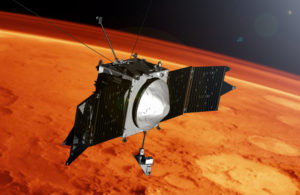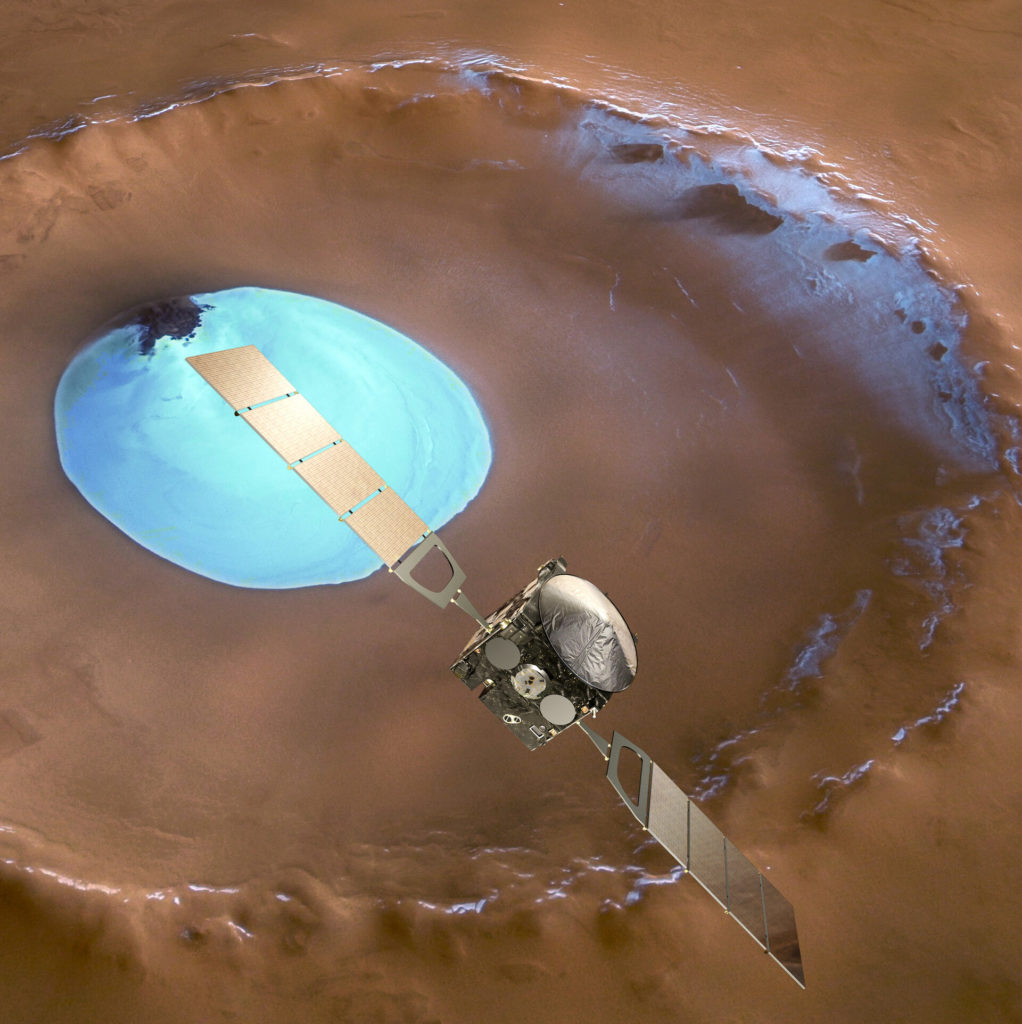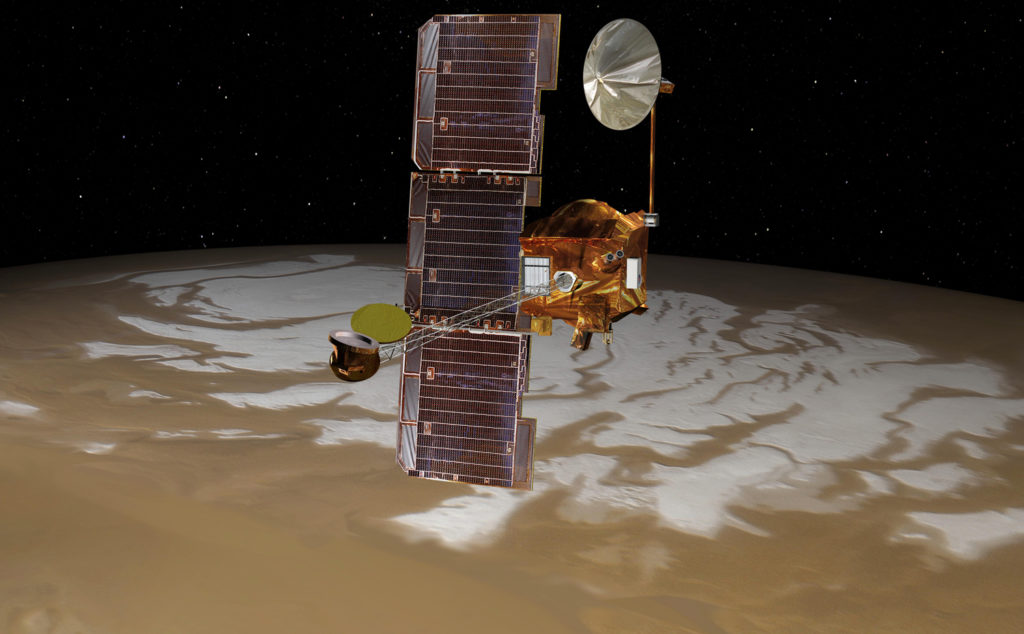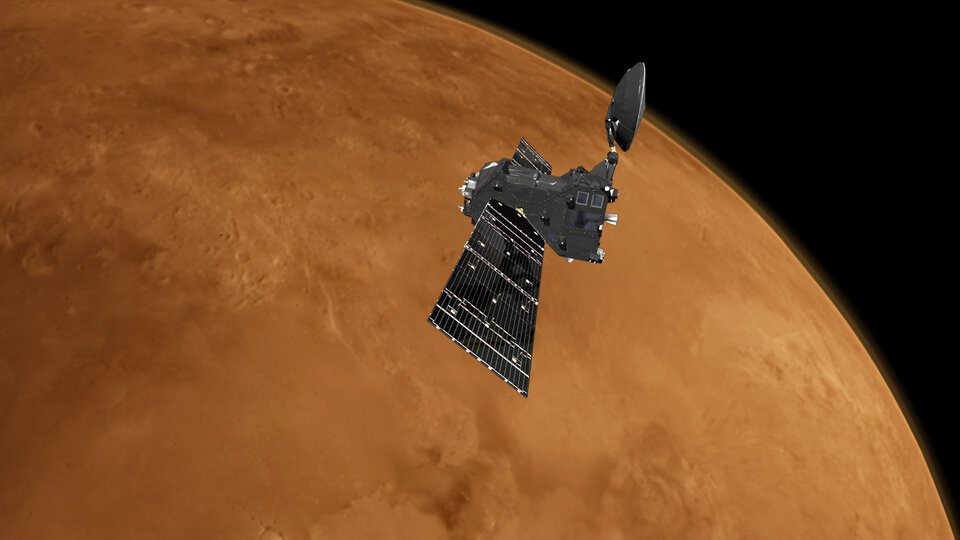International Mars Missions
Past Missions
Current Missions
NASA Curiosity Rover
Emirates Mars Mission: Hope Probe
NASA: Mars Atmosphere and Volatile Evolution (MAVEN)
ESA, ASI, NASA: Mars Express
NASA: Mars Odyssey
ISRO: Mars Orbiter Mission (MOM)
NASA: Mars Reconnaissance Orbiter (MRO)
NASA: Perseverance Rover
CNSA: Tianwen-1
ESA, ROSCOSMOS: Exo Mars Trace Gas orbiter (TGO)
- JAXA: Martian Moons Exploration (MMX)
NASA: Escapade
ISRO: Mangalyaan 2
NICT, ISSL: TEREX
ROSCOSMOS: Mars-Grunt
ESA: Rosalind Franklin ExoMars Rover
NASA, ESA: Mars Sample Return
NASA, CSA, ASI, JAXA: international Mars ice Mapper (I-MIM)
CNSA: Mars Sample Return
2018-2022
InSight, short for Interior Exploration using Seismic Investigations, Geodesy and Heat Transport, was a Mars lander designed to study in-depth the “inner space” of Mars: its crust, mantle, and core.
During its mission, InSight:
- Detected the first quake on another planet
- Gathered new information about Mars’ three major layers – crust, mantle and core
- Detected a magnitude 4 marsquake caused by a meteorite strike. The meteorite impact revealed water ice buried underground – closer to the Martian equator than anything discovered previously.
- Carried the first ever magnetometer instrument to the Martian surface, enabling it to detect magnetic signals
- Collected the most comprehensive weather data of any mission sent to the surface of Mars
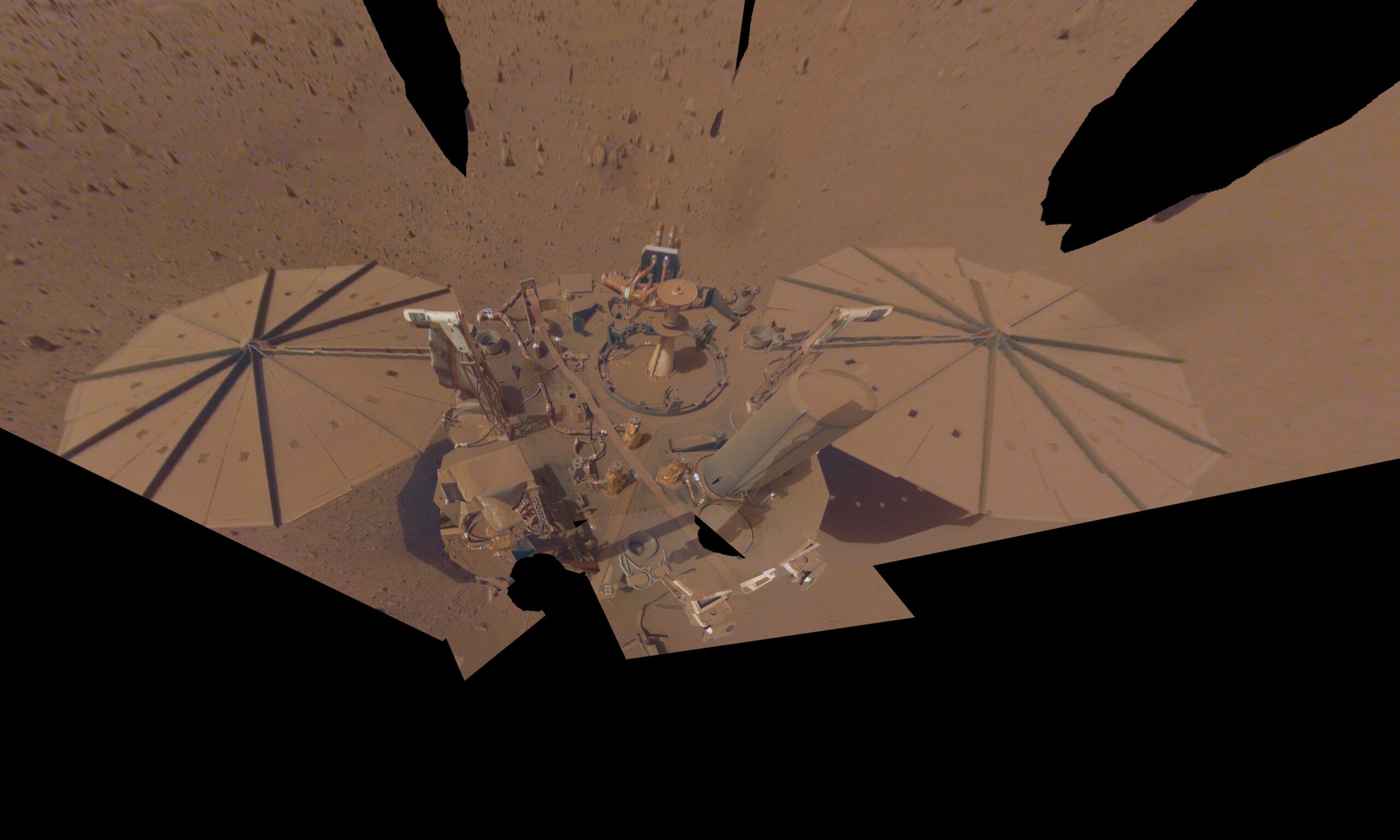
InSight’s final selfie. Image Credit: NASA/JPL-Caltech
Current Missions
2011-present
Part of NASA’s Mars Science Laboratory mission, Curiosity is the largest and most capable rover ever sent to Mars. It launched Nov. 26, 2011 and landed on Mars on Aug. 5, 2012.
Early in its mission, Curiosity’s scientific tools found chemical and mineral evidence of past habitable environments on Mars. It continues to explore the rock record from a time when Mars could have been home to microbial life.
InSight on Mars: An artist illustration of the InSight lander on Mars. Credit: NASA/JPL-CaltechReturn to top
Emirates Mars Mission: Hope Probe
2020-present
The Emirates Mars Mission (EMM) is the United Arab Emirates’ (UAE) first mission to Mars. EMM’s Hope Probe is designed to orbit Mars and study the dynamics in the Martian atmosphere on a global scale, and on both diurnal and seasonal timescales. Using three scientific instruments on board the spacecraft, EMM will provide a set of measurements fundamental to an improved understanding of circulation and weather in the Martian lower and middle atmosphere. Combining such data with the monitoring of the upper layers of the atmosphere, EMM measurements will reveal the mechanisms behind the upward transport of energy and particles, and the subsequent escape of atmospheric particles from the gravity of Mars.
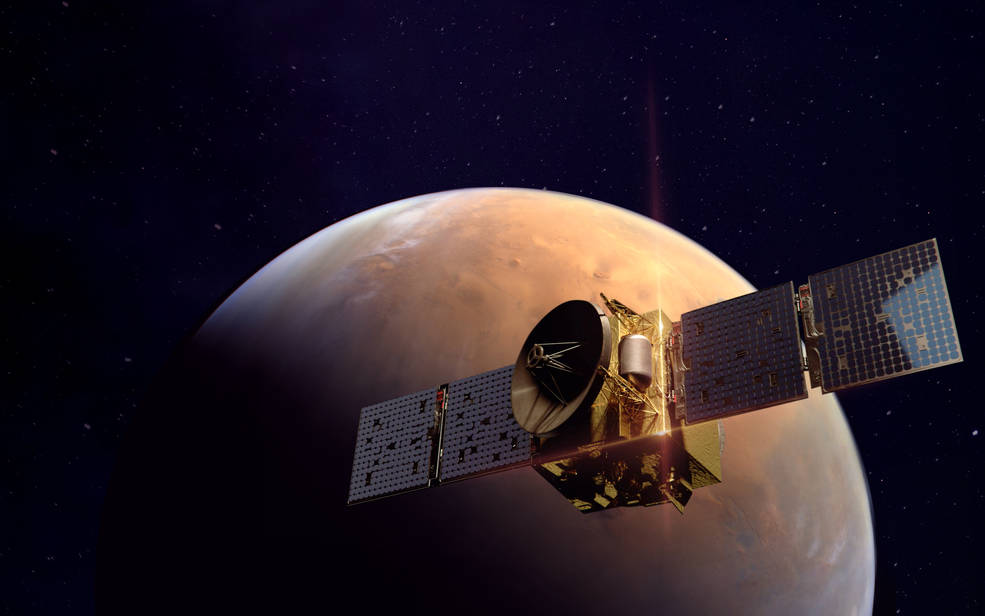
A rendition of the Emirates Mars Mission “Hope Probe” in orbit around Mars. Copyright: UAE Space Agency
NASA: Mars Atmosphere and Volatile Evolution (MAVEN)
2013-present
The Mars Atmosphere and Volatile Evolution mission (MAVEN) launched on November 18, 2013, and entered orbit around Mars on September 21, 2014. The mission’s goal is to explore the planet’s upper atmosphere, ionosphere, and interactions with the Sun and solar wind. Scientists will use MAVEN data to explore the loss of volatile compounds—such as CO2 N2 and H2O—from the Martian atmosphere to space. Understanding atmospheric loss will give scientists insight into the history of Mars’ atmosphere and climate, liquid water, and planetary habitability.
MAVEN spacecraft orbiting Mars (Artist’s concept). Copyright: NASA/GSFC
2003-present
Mars Express is Europe’s first mission to the Red Planet. It carries seven instruments and deployed a lander, Beagle 2. The lander was lost during its attempt to reach the planet’s surface but the orbiter continues its highly successful on-going global investigation of Mars and its two moons, Phobos and Deimos.
Since beginning science operations in 2004, the mission has provided views of Mars in three dimensions, tracing the history of water across the planet. This demonstrates that Mars once harboured environmental conditions that may have been suitable for life. Key discoveries include the presence of minerals that form only in the presence of water, the detection of water-ice deposits underground, and evidence to suggest volcanism on Mars may have persisted until recent times.
The spacecraft has also provided relay communication services between the Earth and the NASA rovers on the surface, forming a centrepiece of the international effort in exploring Mars.
Mars Express over Water Ice Crater (Artist’s concept). Copyright: ESA/Mars Express
2001-present
The 2001 Mars Odyssey mission is NASA’s longest-lasting Mars spacecraft . The spacecraft launched on April 7, 2001, and arrived at Mars on October 24, 2001. Its mission includes making the first global map of the amount and distribution of many chemical elements and minerals that make up the Martian surface. It successfully completed its primary science mission from February 2002 through August 2004. The orbiter’s extended operations continue today.
The Odyssey orbiter is a communications relay for rovers and landers on Mars. Images and other measurements from Mars Odyssey help identify potential landing sites for future rovers and landers.
Mars Odyssey in orbit (Artist’s concept). Copyright: NASA/JPL-Caltech
ISRO: Mars Orbiter Mission (MOM)
2013-present
ISRO’s Mars Orbiter Mission – also known as MOM or Mangalyaan – has successfully demonstrated India’s technological capability for interplanetary exploration.
MOM carries five scientific payloads to study Martian surface features, morphology, mineralogy and the Martian atmosphere. Analysis of MOM data is currently underway.
Mission support for MOM includes ground station support from INPE (Instituto Nacional de Pesquisas Espaciais), SANSA (South African National Space Agency), and NASA JPL (National Aeronautics and Space Administration Jet Propulsion Laboratory).
Mangalyaan orbiter preparing for launch. Copyright: ISRO/PSLV-C25/Mars Orbiter Mission.
NASA: Mars Reconnaissance Orbiter (MRO)
2005-present
NASA’s Mars Reconnaissance Orbiter blasted off from Cape Canaveral in 2005, on a search for evidence that water persisted on the surface of Mars for long periods of time. While other Mars missions have shown that water flowed across the surface during Mars’ history, it remains a mystery as to whether water was ever around long enough to provide a habitat for life.
MRO makes use of the HiRISE camera, the most powerful camera ever sent to another planet. The camera’s high resolution capability (imaging up to 30 centimeters per pixel) remains unprecedented for any existing orbiter in the study of the Red Planet, as well as being an indispensable instrument for helping to select landing sites for robotic and future human exploration.
Also aboard MRO is CRISM, an imaging spectrometer with a scannable field of view that can cover wavelengths in both the visible range and shorter wavelengths within the infrared range. Being able to detect light in these wavelength ranges enables the CRISM team to identify a broad range of minerals on the Martian surface.
NASA Mars Reconnaissance Orbiter mission over Mars. Copyright: NASA/JPL-Caltech
2020-present
The Mars 2020 Perseverance Rover is searching for signs of ancient microbial life, which will advance NASA’s quest to explore the past habitability of Mars. The first leg of a Mars sample return campaign, Perseverance has a drill which will collect core samples of Martian rock and soil, then store them in sealed tubes for pickup by future missions that will ferry them back to Earth for detailed analysis. Perseverance is also testing technologies to help pave the way for future human exploration of Mars.
The Perseverance mission is testing multiple novel technologies that will advance future missions to Mars. Ingenuity, the Mars Helicopter, tested the first powered flight on Mars, and opens the door for future aerial exploration missions. The Mars Oxygen In-Situ Resource Utilization Experiment (MOXIE) is testing turning atmospheric carbon dioxide into oxygen. The Radar Imager for Mars’ Subsurface Experiment, (RIMFAX) uses radar waves to probe the ground under the rover.
Perseverance Rover on Mars. Copyright: NASA/JPL-Caltech/MSSS
2021-present
Tianwen-1 (“questions to heaven,” or “questioning the heavens”) is China’s first Mars mission, consisting of an orbiter and a rover named Zhurong. It entered Mars orbit in February 2021 and Zhurong landed on May 14, 2021.
Zhurong was China’s first success at landing a rover on the surface of Mars. The rover demonstrated crucial entry, descent and landing technologies including an aeroshell, supersonic parachute, sensor systems and retropulsion needed for a soft landing on Mars.
The rover includes a radar instrument designed to detect subsurface water, with the implication that this water may be supportive of life. ESA’s Mars Express spacecraft found evidence for subsurface water using radar from orbit, but along with NASA’s Perseverance rover, this will be the first time a rover has searched from the ground.
Between the rover and orbiter, there are eight instruments. They include cameras, a radar system, climate sensors and a laser spectrometer. Some surface features, such as possible sedimentary material and potential mud volcanoes, hint at the historical flow of water, so scientists are looking for any clues that there was once water or ice below the surface.

Zhurong rover selfie with the Tianwen-1 lander, taken by the deployable Tianwen-1 Remote Camera. Copyright: CNSA
2015-present
The ExoMars programme comprises two missions: the first – the Trace Gas Orbiter – launched in 2016 while the second, carrying the Rosalind Franklin rover, will target launch in 2028. Together they will address the question of whether life has ever existed on Mars.
TGO’s main objectives are to search for evidence of methane and other trace atmospheric gasses that could be signatures of active biological or geological processes.
The 2016 TGO will act as a relay for the mission.
2024
MMX (Martian Moons eXploration) is a mission to explore the Martian moons.
Mars has two moons – Phobos and Deimos. MMX is planning to collect surface material from Phobos and bring it back to the Earth. MMX is currently under development, with current plans to launch in the mid-2020s.
Some of the main goals of MMX include establishing the technology required for a return trip between Earth and Mars, implementing advanced sampling techniques on celestial bodies, and achieving greater understanding of the formation of Martian moons.

Martian Moons eXploration mission trajectory plan. Copyright: JAXA
2024
The Escape and Plasma Acceleration and Dynamics Explorers (EscaPADE) are a dual-spacecraft mission to study ion and sputtered escape from Mars.
The two identical spacecraft were scheduled for launch as secondary satellites on the Psyche mission in August 2022, but are now scheduled to launch on an early flight of Blue Origin’s New Glenn rocket.
The science goals of the mission are to: understand the processes controlling the structure of Mars’ hybrid magnetosphere and how it guides ion flows, understand how energy and momentum are transported from the solar wind through Mars’ magnetosphere and understand the processes controlling the flow of energy and matter into and out of the collisional atmosphere.
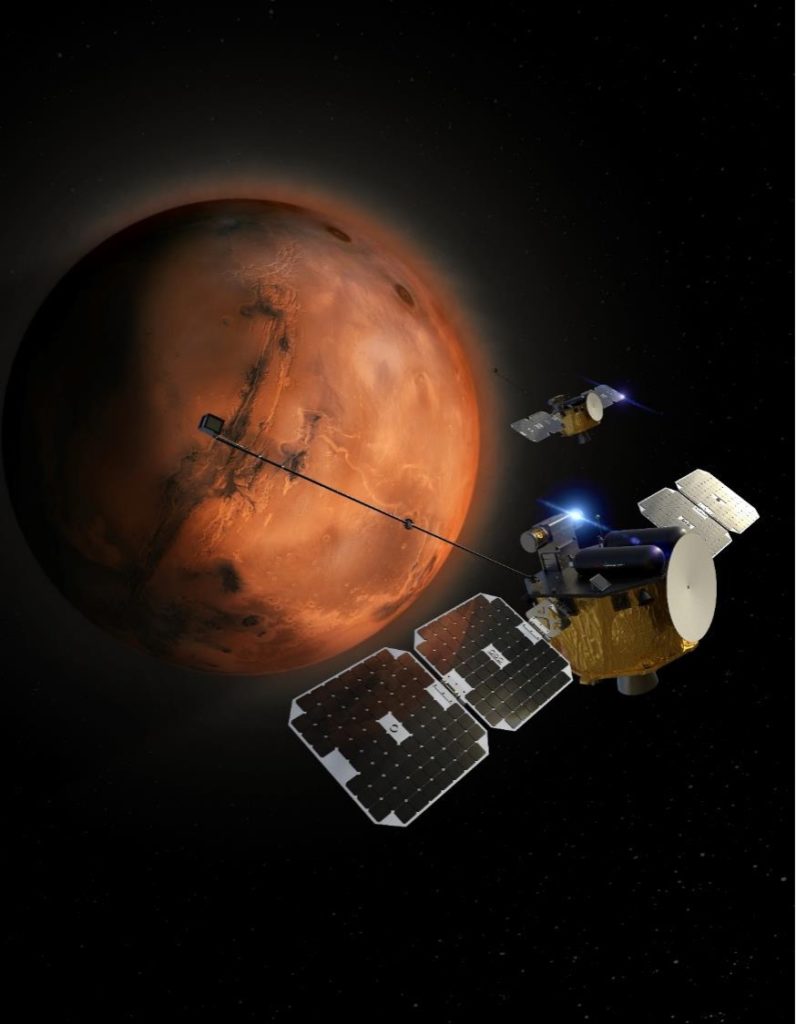
ESCAPADE. Copyright: Rocket Lab USA/UC Berkeley
The planned successor to MOM, Mangalyaan 2 is a proposed orbiter intended to continue studies of the Martian surface and sub-surface and serve as a continued communication link to Earth. The understanding of the temporal evolution of the Martian atmosphere necessitates new measurements to quantify the loss of atmospheric water and carbon dioxide.
This new Mars mission provides an opportunity to address questions regarding planetary evolutionary processes, how and whether life arose elsewhere in the solar system and the interplay between geological and possible biological history.
ISRO plans to launch this mission by 2025.
Mid-2020s
The Tera-hertz Explorer (TEREX) mission is a planned orbiter and lander that will be carrying a terahertz sensor to the surface of Mars to measure the oxygen isotope ratios of various molecules in the Martian atmosphere. The objective of the mission is to understand the chain of chemical reactions that resupply the atmosphere with carbon dioxide.
The lander, TEREX-1, was originally intended to launch as a piggyback with another payload during the July 2020 Mars launch window, but this has been delayed to the mid 2020s. The spacecraft will orbit Mars for a short while before landing the instrument on the surface. A dedicated orbiter, TEREX-2, was planned for launch in 2024. It will conduct a global survey of the Martian atmosphere and surface for water and oxygen levels.

Mars-Grunt, also known as Expedition-M, is a robotic spacecraft sample return mission proposed to be sent to Mars in mid-2020s. Approximately 0.2kg of ground samples are planned to be retrieved.
This mission would include an orbiter, a lander, and a small rocket in the top of the lander to blast the ascent vehicle for rendezvous and docking with the orbiter for the soil sample transfer into the return vehicle.
ESA: Rosalind Franklin ExoMars Rover
2028
A European rover named for Rosalind Franklin is part of the ExoMars programme that will now utilize a European-built surface lander to deliver the rover to the Martian surface.
The rover will be the first mission to combine the capability to move across the surface and to study Mars at depth.
It will collect samples with a drill down to a depth of 2m and analyze them with next-generation instruments in an onboard laboratory. Underground samples are more likely to include biomarkers, since the Martian atmosphere offers little protection from radiation at the surface.

An artist’s impression of the ExoMars rover on the surface of Mars. Copyright: ESA/ATG medialab
Late 2020s
The Mars Sample Return Campaign is a partnership between NASA and the European Space Agency (ESA) to conduct a series of missions designed to bring samples of Martian rocks and soil safely back to Earth, where they can be investigated in unprecedented detail, using all the capabilities of terrestrial laboratories.
The sample return mission architecture is designed to continue the work begun by NASA’s Mars 2020 Perseverance rover, which has already collected and cached a set of scientifically meaningful samples for future retrieval.
The next steps include a Sample Retrieval Lander and Mars Ascent Vehicle which will deliver samples to an ESA-led Earth Return Orbiter. After recovery on Earth, samples will be stored and made available to scientists around the world to look for signs of past life on Mars and perform many other studies beyond the capabilities of instruments delivered to Mars.
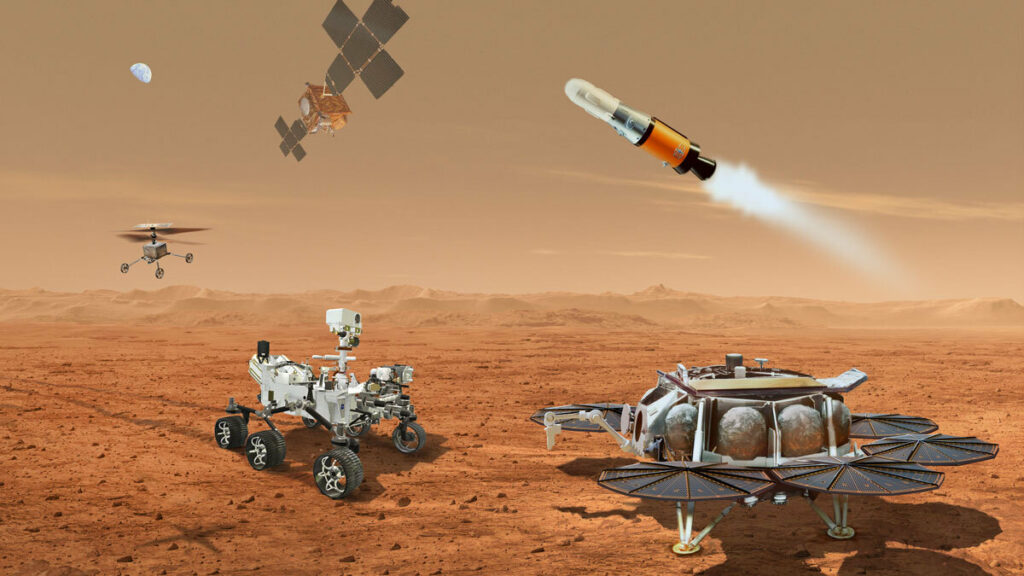
This illustration shows a concept for multiple robots that would team up to ferry to Earth samples of rock and soil collected from the Martian surface by NASA’s Mars Perseverance rover. Copyright: NASA/JPL-Caltech.
ASI, CSA, JAXA, NASA: International Mars Ice Mapper (I-MIM)
Early 2030s
NASA, CSA, ASI, and JAXA have signed a statement of intent to advance a possible robotic Mars ice mapping mission, which could help identify abundant, accessible ice for future candidate landing sites on the Red Planet. If the concept moves forward, the mission could be ready to launch as early as 2026.
The international Mars Ice Mapper mission would detect the location, depth, spatial extent, and abundance of near-surface ice deposits, which would enable the science community to interpret a more detailed volatile history of Mars. The radar-carrying orbiter would also help identify properties of the dust, loose rocky material – known as regolith – and rock layers that might impact the ability to access ice.
The ice-mapping mission could help the agency identify potential science objectives for initial human missions to Mars.
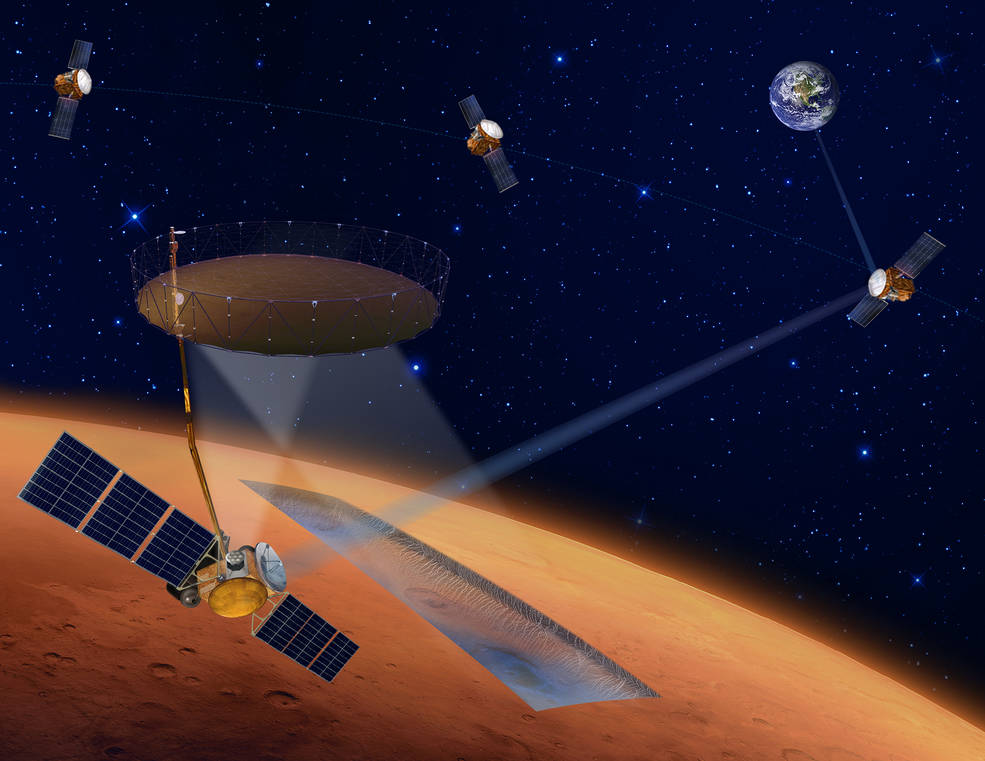
I-MIM proposed architecture (artist’s concept). Copyright: NASA
China is working on a complex mission to collect Mars rock samples and deliver them to Earth by building on the successes of recent Moon and Mars missions. The mission, likely to be named Tianwen-2, could launch as soon as 2028 with the goal of returning samples around 2030. Such a mission has never before been attempted.
China’s ambition to carry out the unprecedented mission has been stated previously and was included in the China National Space Administration’s plans for development across 2021-2025.

